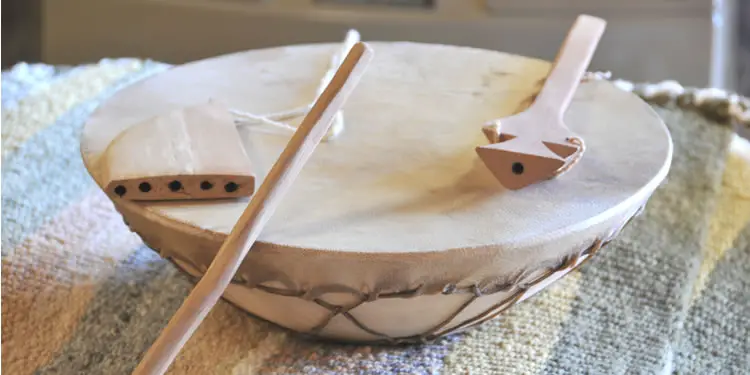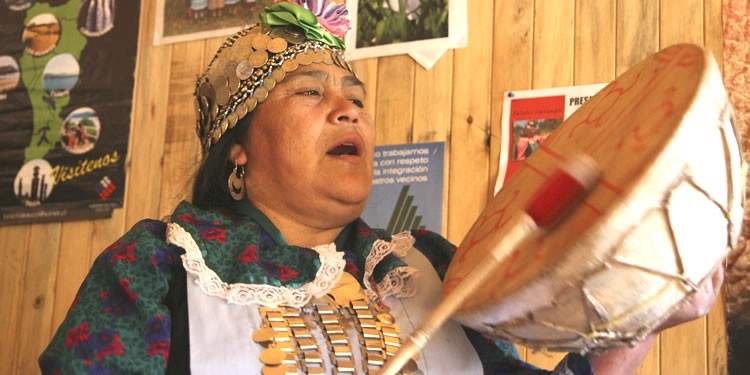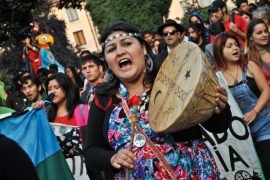Mapuche Araucano Culture
Detailed Information about Mapuche culture and Araucana
Indigenous ethnic groups have dwelled on the soil of Neuquén for thousands of years. Vestiges such as cave paintings and engravings made by the most ancient cultures are still preserved. The last groups to inhabit the territory of Neuquén, before the conquest, were the PUELCHES, the PEHUENCHES and the MAPUCHES.
Puelches
They were given that name by the Chilean Mapuches, as it stands for ?people from the East”. Grouped in tribes ruled by a chief, they were monogamous, though the chiefs and important figures could have several wives.
They were tall and had a longish head, which they used to deform artificially on babies.
They were nomads and their food was obtained from the guanaco and the rhea, which they would hunt with bows and arrows, as well as with boleadoras. They also collected roots and seeds and prepared alcoholic beverages.
They lived in tepees made of animal skins and dressed with the quillango, a blanket made with guanaco skins whose fur they wore next to their own skin. They would decorate the outer side with geometrical drawings. They held their hair with a hair band and wore leather moccasins. They would also paint their faces according to the occasion.
As from the XVI century, the Mapuches or Araucanos started to penetrate the area coming from Chile and gradually spread all around Patagonia and the Argentinian Pampas. The Puelches mingled with them and adopted their customs and tongue.
The Mapuches also imitated the Tehuelches? lifestyle. For instance, they copied their dwellings and their nomad behavior, which let them become adapted to the new territory.
Pehuenches
The Pehuenches inhabited the area of the monkey-puzzle trees or pehuenes. They were tall and slim. Their skin was dark and they had wavy hair.
Their food was based on the monkey-puzzle tree pine-nuts which they harvested and preserved in underground silos during the winter. They used the nuts to make a kind of bread and a beverage similar to chicha. They hunted guanacos and collected wild seeds and fruit.
They used animal skins to make their dwellings and also their dresses, which they ornamented with feathers.
Little by little, after the infiltration of the Araucanos from Chile who settled down among them, they started to adopt their habits and lost almost all their primitive customs and even their physical characteristics.
Mapuches
Also called Araucanos, this nation from the Chilean territory spread all around Argentina. In the times of the colony, they occupied all the pampas territory and northern Patagonia up to a part of Santa Cruz, about 250 years ago.
This immigration gave way to an adaptation and merger process with the peoples who had settled down in this area before their arrival. This happened without any violence or displacement.
They did resist the white penetration and were moved southwards, where they offered strong resistance and started their migration to Patagonia and La Pampa.
They were small and had a short head. In Chile, they were farmers: they grew corn, potatoes, peppers, beans, pumpkins and other vegetables. When they crossed onto Argentina, they took up hunting and gathering, becoming adapted to the nomad style of life.
They lived in tepees, which they transported from one place to another. They would sleep on sheep skins.
They dressed chiripa, poncho and leather boots. The women wore their hair in two long plaits and covered themselves with blankets which they tied to their waists with colorful sashes.
Their weapons included the boleadoras, which they tied around their waists, the sling and the spear, which they used against the Spanish during the conquest, especially after they started riding horses. As a defensive weapon, they also used a kind of helmet made of raw leather and a shield.
The mapuche tongue prevailed over the languages of the previous cultures.
They were polygamous. The number of wives varied according to how rich they were.
Even though the idea of a supreme being is a consequence of the Christian influence, today they hold wonderful pagan celebrations that respect their ancient beliefs. The NGUILLATUN, during which prayers are said to NGUENECHEN, the lord of the Indians, ?owner of the people?, is among the most famous. During this celebration, they perform several rites including the so-called loncomeo dance.
One of its figures was the choique purrún, in which the dancers imitated the movements of the rhea or choique.
The intervention of the machi or shaman, a kind of medic or sorceress, was essential. She was in charge of healing using herbs and other procedures such as spells, animal sacrifices and smoke puffs. The ceremony was performed on a valley, where they raised an altar they called rehue with planted poles or canes.
The colors of the nguillatún are blue (from the sky) and yellow (from the sun). Sometimes they also used green (from the grass).
Native Musical Instruments

The inhospitable climate and the struggle to survive in this land covered with snow for so many months give the music a sorrowful character in which passion is cruel and hopeless. Passion cannot even be expressed through weeping or love. That is the reason for the simplicity of their musical instruments and the fact that the araucano music is charged with moan and anguish.
They used several musical instruments: cultrun, trutruca, pifilca, ñorquin, quinquer-cahue, or araucano fiddle.
- Cultrun:a drum made with a piece of hollow wood, shaped as a kettledrum. It is lined with horse skin tightly held. It is beat with only one stick whose handle is ornamented with colorful threads.
- Pifilca:a flute made of wood or bone. It is short and sounds like a whistle. They hang it from their necks with a string. At present, it is carved in 30 to 40-centimeter wooden pieces. The lower end of the tube is closed and holes are opened to half-way its length. It gives out only one sound and this sole note is mixed throughout a song or an instrumental piece without any rhythmic or tune relation with the rest.
- Trutruca:this instrument is made with a colihue cane with a length of up to four meters. It is cut in half in order to make it hollow. Afterwards, the two halves are tied with a wool thread and it is wrapped in horse guts. A cow horn is placed at one end and it is blown through the opposite end. Its sound resembles the bellowing of a bull and it represents the tribe?s strength. This is one of the two kinds of large aerophones existing in our country (the other one is the erke)
- Quinquercahue:it had two arches (generally made out of rib bones) completed with only one string made of horse mane. It was played by placing one of the arches ?the body of the fiddle- against the upper incisors with the left hand. The right hand, in turn, passed the string from the other arch ?the fiddle?s arch- over the previous one, thus producing a plaintive and sorrowful sound.
- Lolquin:similar to the trutruca but much smaller. It is made with thistle cane, called troltro.
- Clarín:it was known upon the arrival of the Spanish and imitated with local materials (vegetable cane and wood)
- Cullcull:it was the bugle used as an alarm in case of emergency or war. It was made with ox horns.
- Pinquilhue:from remote times, it was a kind of flute made with the stem of the colihue
- Caquel cultrum:it is a drum made with the hollow cut of a log.
- Huala:a kind of maraca, made with a gourd that sounds with dry pips and sometimes small pebbles inside.
- Cada Cada:large shells that sound by rubbing their edges and striped faces. Several of the abovementioned instruments are usually played altogether during the ritual ceremonies: nguillatunes and machitunes.

What Are the First Peoples?
A dictionary explains that the name ?first peoples? refers ethnic groups native to a geographical region or land, before the arrival of a foreign culture. However, the meaning goes much deeper and in the last few years this subject has inspired true respect. Nowadays, the first peoples in the American continent have begun to vindicate their culture, their philosophy of life and their interests within the democratic society of modern societies.
This is also evidenced in the treatment of the matter by the mass media, the political agenda of each country and a great deal of social, civil and non-governmental organizations that struggle for their rights and their inclusion in today?s world. All around our Patagonia, generations of men and women coming from this original lineage still try to preserve their inherited culture, history, traditions, visions of the world and lifestyles through their own customs and in perfect combination with the surrounding environment.

